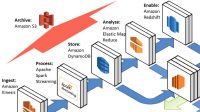Big Data Analytics
Big Data analytics involves several stages of data processing, including data collection, storage, processing, analysis, and visualization. Here’s an overview of the key components of Big Data analytics:
- Data Collection: Data collection involves gathering data from various sources, such as sensors, social media platforms, customer interactions, and transaction records. This data is stored in databases or data lakes for further processing.
- Data Storage and Processing: Big Data requires scalable storage solutions, such as distributed file systems or cloud-based storage. Data processing frameworks, such as Hadoop or Apache Spark, enable distributed processing of large datasets across clusters of computers.
- Data Analysis and Visualization: Once the data is processed, advanced analytics techniques are applied to extract meaningful insights. This may involve statistical analysis, machine learning algorithms, or predictive modeling. The results are then visualized using charts, graphs, or dashboards to facilitate easier interpretation and decision-making.
- Real-time Analytics: Big Data analytics also includes real-time or near real-time analytics, where data is analyzed as it is generated. This enables organizations to respond quickly to changing conditions, detect anomalies, and make instant decisions based on up-to-date information.
- Data Governance and Ethics: As Big Data involves handling vast amounts of data, organizations need to establish data governance practices to ensure data quality, privacy, and compliance with regulations. Ethical considerations regarding the use of data also play a crucial role in Big Data analytics.
Future Trends in Big Data
The field of Big Data is continuously evolving, and several trends are shaping its future. Here are some key trends to watch out for:
- Edge Computing: With the proliferation of Internet of Things (IoT) devices, data is increasingly being generated at the edge of the network. Edge computing brings data processing closer to the source, reducing latency and enabling real-time insights without the need for transmitting all data to centralized servers.
- Artificial Intelligence (AI) Integration: AI techniques, such as machine learning and natural language processing, are being integrated with Big Data analytics to enhance data processing, automate decision-making, and enable advanced insights. AI-powered algorithms can uncover hidden patterns, detect anomalies, and make accurate predictions.
- Data Privacy and Ethics: As data privacy concerns continue to grow, there will be a greater emphasis on ethical and responsible use of Big Data. Organizations will need to adopt transparent data practices, ensure consent-based data collection, and prioritize user privacy to maintain trust.
- Streaming Analytics: Real-time streaming analytics will become more prevalent, enabling organizations to analyze data in motion. This allows for immediate detection of trends, anomalies, and opportunities, leading to faster response times and proactive decision-making.
- Data Democratization: The democratization of data will empower more individuals within organizations to access and analyze data. Self-service analytics tools and user-friendly interfaces will make it easier for non-technical users to explore and gain insights from Big Data.
Conclusion
Big Data has revolutionized the way organizations collect, store, process, and analyze data. It provides valuable insights that drive decision-making, improve operational efficiency, and enhance customer experiences. However, the challenges of managing and extracting value from Big Data should not be overlooked. As technology continues to advance, the future of Big Data holds immense possibilities, with trends like edge computing, AI integration, and data privacy shaping its evolution. Organizations that harness the power of Big Data and leverage advanced analytics techniques will gain a competitive advantage in the data-driven era.





